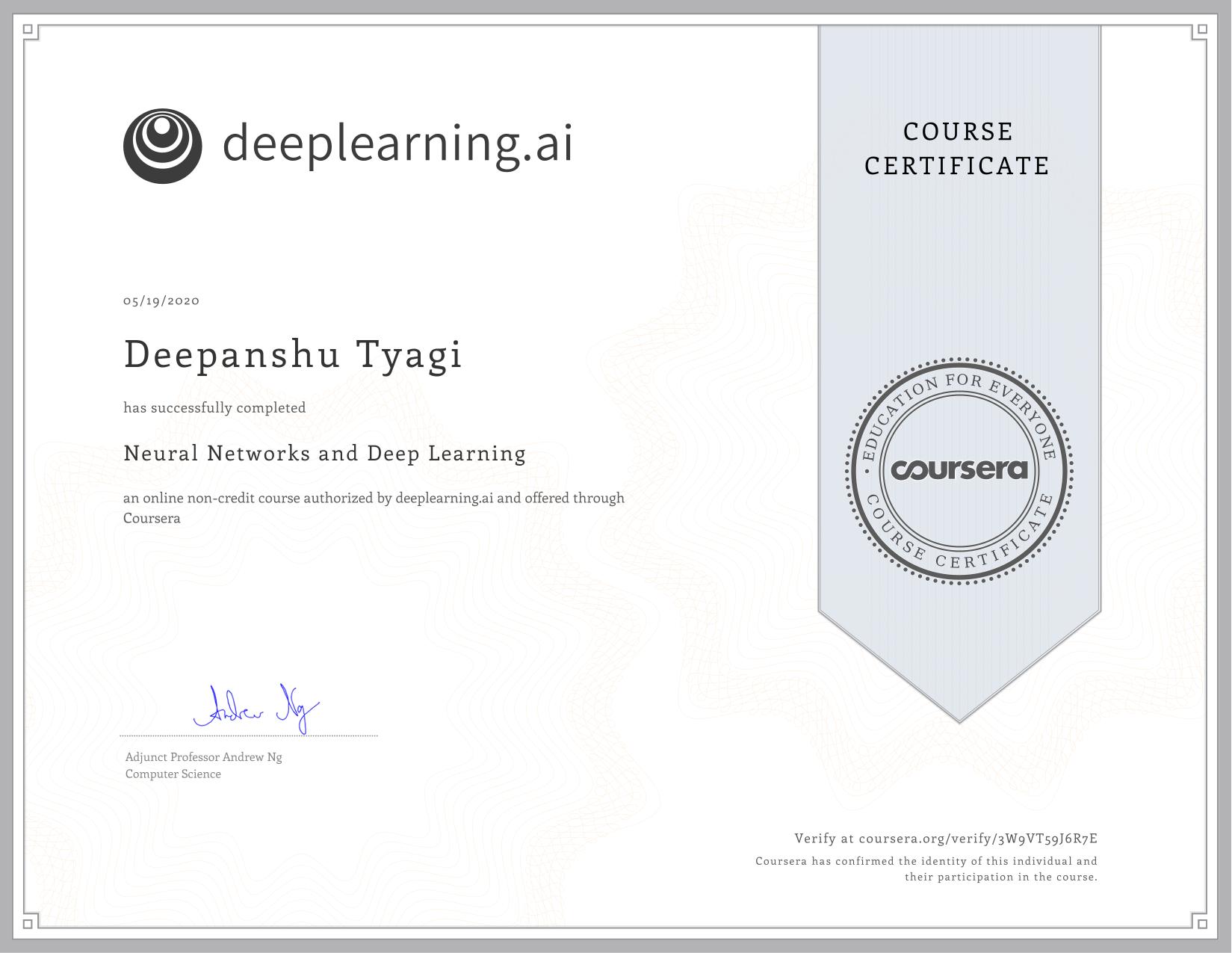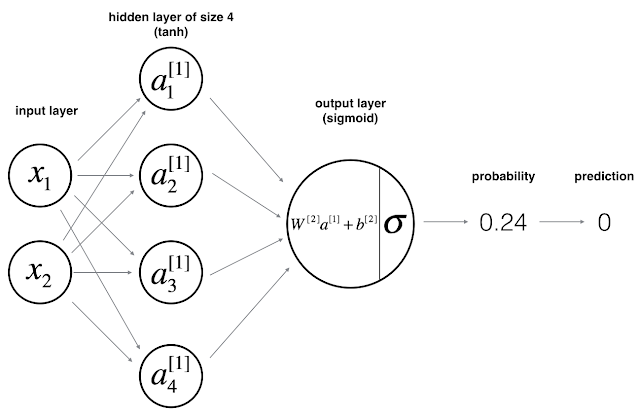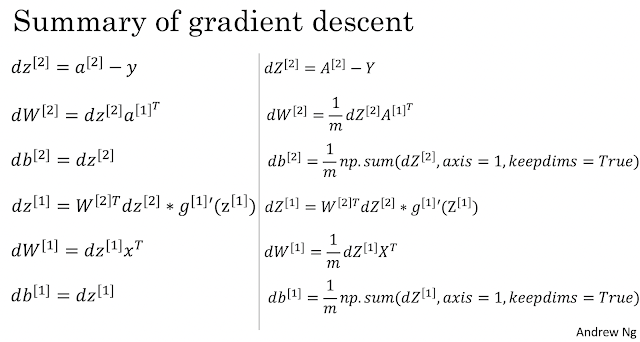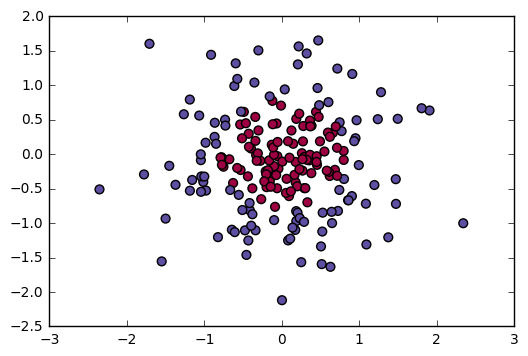Deep-Learning-Specialization-Coursera
This repo contains the updated version of all the assignments/labs (done by me) of deep learning specialization on coursera by andrew ng. it includes building various deep learning models from scratch and implementing them for object detection, facial recognition, autonomous driving, neural machine translation, trigger word detection, etc., deep learning specialization coursera [updated version 2021].


Announcement
[!IMPORTANT] Check our latest paper (accepted in ICDAR’23) on Urdu OCR

This repo contains all of the solved assignments of Coursera’s most famous Deep Learning Specialization of 5 courses offered by deeplearning.ai
Instructor: Prof. Andrew Ng
This Specialization was updated in April 2021 to include developments in deep learning and programming frameworks. One of the most major changes was shifting from Tensorflow 1 to Tensorflow 2. Also, new materials were added. However, Most of the old online repositories still don’t have old codes. This repo contains updated versions of the assignments. Happy Learning :)
Programming Assignments
Course 1: Neural Networks and Deep Learning
- W2A1 - Logistic Regression with a Neural Network mindset
- W2A2 - Python Basics with Numpy
- W3A1 - Planar data classification with one hidden layer
- W3A1 - Building your Deep Neural Network: Step by Step¶
- W3A2 - Deep Neural Network for Image Classification: Application
Course 2: Improving Deep Neural Networks: Hyperparameter tuning, Regularization and Optimization
- W1A1 - Initialization
- W1A2 - Regularization
- W1A3 - Gradient Checking
- W2A1 - Optimization Methods
- W3A1 - Introduction to TensorFlow
Course 3: Structuring Machine Learning Projects
- There were no programming assignments in this course. It was completely thoeretical.
- Here is a link to the course
Course 4: Convolutional Neural Networks
- W1A1 - Convolutional Model: step by step
- W1A2 - Convolutional Model: application
- W2A1 - Residual Networks
- W2A2 - Transfer Learning with MobileNet
- W3A1 - Autonomous Driving - Car Detection
- W3A2 - Image Segmentation - U-net
- W4A1 - Face Recognition
- W4A2 - Neural Style transfer
Course 5: Sequence Models
- W1A1 - Building a Recurrent Neural Network - Step by Step
- W1A2 - Character level language model - Dinosaurus land
- W1A3 - Improvise A Jazz Solo with an LSTM Network
- W2A1 - Operations on word vectors
- W2A2 - Emojify
- W3A1 - Neural Machine Translation With Attention
- W3A2 - Trigger Word Detection
- W4A1 - Transformer Network
- W4A2 - Named Entity Recognition - Transformer Application
- W4A3 - Extractive Question Answering - Transformer Application
I’ve uploaded these solutions here, only for being used as a help by those who get stuck somewhere. It may help them to save some time. I strongly recommend everyone to not directly copy any part of the code (from here or anywhere else) while doing the assignments of this specialization. The assignments are fairly easy and one learns a great deal of things upon doing these. Thanks to the deeplearning.ai team for giving this treasure to us.
Connect with me
Name: Abdur Rahman
Institution: Indian Institute of Technology Delhi
Find me on:

Deep-Learning-Specialization
Coursera deep learning specialization, neural networks and deep learning.
In this course, you will learn the foundations of deep learning. When you finish this class, you will:
- Understand the major technology trends driving Deep Learning.
- Be able to build, train and apply fully connected deep neural networks.
- Know how to implement efficient (vectorized) neural networks.
- Understand the key parameters in a neural network’s architecture.
Week 1: Introduction to deep learning
Be able to explain the major trends driving the rise of deep learning, and understand where and how it is applied today.
- Quiz 1: Introduction to deep learning
Week 2: Neural Networks Basics
Learn to set up a machine learning problem with a neural network mindset. Learn to use vectorization to speed up your models.
- Quiz 2: Neural Network Basics
- Programming Assignment: Python Basics With Numpy
- Programming Assignment: Logistic Regression with a Neural Network mindset
Week 3: Shallow neural networks
Learn to build a neural network with one hidden layer, using forward propagation and backpropagation.
- Quiz 3: Shallow Neural Networks
- Programming Assignment: Planar Data Classification with Onehidden Layer
Week 4: Deep Neural Networks
Understand the key computations underlying deep learning, use them to build and train deep neural networks, and apply it to computer vision.
- Quiz 4: Key concepts on Deep Neural Networks
- Programming Assignment: Building your Deep Neural Network Step by Step
- Programming Assignment: Deep Neural Network Application
Course Certificate

Navigation Menu
Search code, repositories, users, issues, pull requests..., provide feedback.
We read every piece of feedback, and take your input very seriously.
Saved searches
Use saved searches to filter your results more quickly.
To see all available qualifiers, see our documentation .
- Notifications You must be signed in to change notification settings
Notes, programming assignments and quizzes from all courses within the Coursera Deep Learning specialization offered by deeplearning.ai: (i) Neural Networks and Deep Learning; (ii) Improving Deep Neural Networks: Hyperparameter tuning, Regularization and Optimization; (iii) Structuring Machine Learning Projects; (iv) Convolutional Neural Network…
amanchadha/coursera-deep-learning-specialization
Folders and files, repository files navigation, deep learning specialization on coursera (offered by deeplearning.ai).
Programming assignments and quizzes from all courses in the Coursera Deep Learning specialization offered by deeplearning.ai .
Instructor: Andrew Ng
For detailed interview-ready notes on all courses in the Coursera Deep Learning specialization, refer www.aman.ai .
Run setup.sh to (i) download a pre-trained VGG-19 dataset and (ii) extract the zip'd pre-trained models and datasets that are needed for all the assignments.
This repo contains my work for this specialization. The code base, quiz questions and diagrams are taken from the Deep Learning Specialization on Coursera , unless specified otherwise.
2021 Version
This specialization was updated in April 2021 to include developments in deep learning and programming frameworks, with the biggest change being shifting from TensorFlow 1 to TensorFlow 2. This repo has been updated accordingly as well.
Programming Assignments
Course 1: neural networks and deep learning.
- Week 2 - PA 1 - Python Basics with Numpy
- Week 2 - PA 2 - Logistic Regression with a Neural Network mindset
- Week 3 - PA 3 - Planar data classification with one hidden layer
- Week 4 - PA 4 - Building your Deep Neural Network: Step by Step
- Week 4 - PA 5 - Deep Neural Network for Image Classification: Application

Course 2: Improving Deep Neural Networks: Hyperparameter tuning, Regularization and Optimization
- Week 1 - PA 1 - Initialization
- Week 1 - PA 2 - Regularization
- Week 1 - PA 3 - Gradient Checking
- Week 2 - PA 4 - Optimization Methods
- Week 3 - PA 5 - TensorFlow Tutorial
Course 3: Structuring Machine Learning Projects
- There are no programming assignments for this course. But this course comes with very interesting case study quizzes (below).
Course 4: Convolutional Neural Networks
- Week 1 - PA 1 - Convolutional Model: step by step
- Week 1 - PA 2 - Convolutional Neural Networks: Application
- Week 2 - PA 1 - Keras - Tutorial - Happy House
- Week 2 - PA 2 - Residual Networks
- Week 2 - PA 2 - Transfer Learning with MobileNet
- Week 3 - PA 1 - Car detection with YOLO for Autonomous Driving
- Week 3 - PA 2 - Image Segmentation Unet
- Week 4 - PA 1 - Art Generation with Neural Style Transfer
- Week 4 - PA 2 - Face Recognition
Course 5: Sequence Models
- Week 1 - PA 1 - Building a Recurrent Neural Network - Step by Step
- Week 1 - PA 2 - Dinosaur Land -- Character-level Language Modeling
- Week 1 - PA 3 - Jazz improvisation with LSTM
- Week 2 - PA 1 - Word Vector Representation and Debiasing
- Week 2 - PA 2 - Emojify!
- Week 3 - PA 1 - Neural Machine Translation with Attention
- Week 3 - PA 2 - Trigger Word Detection
- Week 4 - PA 1 - Transformer Network
- Week 3 - PA 2 - Transformer Network Application: Named-Entity Recognition
- Week 3 - PA 2 - Transformer Network Application: Question Answering
Quiz Solutions
- Week 1 Quiz - Introduction to deep learning: Text | PDF
- Week 2 Quiz - Neural Network Basics: Text | PDF
- Week 3 Quiz - Shallow Neural Networks: Text | PDF
- Week 4 Quiz - Key concepts on Deep Neural Networks: Text | PDF
- Week 1 Quiz - Practical aspects of deep learning: Text | PDF
- Week 2 Quiz - Optimization algorithms: Text | PDF
- Week 3 Quiz - Hyperparameter tuning, Batch Normalization, Programming Frameworks: Text | PDF
- Week 1 Quiz - Bird recognition in the city of Peacetopia (case study): Text | PDF
- Week 2 Quiz - Autonomous driving (case study): Text | PDF
- Week 1 Quiz - The basics of ConvNets: Text | PDF
- Week 2 Quiz - Deep convolutional models: Text | PDF
- Week 3 Quiz - Detection algorithms: Text | PDF
- Week 4 Quiz - Special applications: Face recognition & Neural style transfer: Text | PDF
- Week 1 Quiz - Recurrent Neural Networks: Text | PDF
- Week 2 Quiz - Natural Language Processing & Word Embeddings: PDF
- Week 3 Quiz - Sequence models & Attention mechanism: Text | PDF
I recognize the time people spend on building intuition, understanding new concepts and debugging assignments. The solutions uploaded here are only for reference . They are meant to unblock you if you get stuck somewhere. Please do not copy any part of the code as-is (the programming assignments are fairly easy if you read the instructions carefully). Similarly, try out the quizzes yourself before you refer to the quiz solutions. This course is the most straight-forward deep learning course I have ever taken, with fabulous course content and structure. It's a treasure by the deeplearning.ai team.
Contributors 9
- Jupyter Notebook 98.6%

- 🌐 All Sites
- _APDaga DumpBox
- _APDaga Tech
- _APDaga Invest
- _APDaga Videos
- 🗃️ Categories
- _Free Tutorials
- __Python (A to Z)
- __Internet of Things
- __Coursera (ML/DL)
- __HackerRank (SQL)
- __Interview Q&A
- _Artificial Intelligence
- __Machine Learning
- __Deep Learning
- _Internet of Things
- __Raspberry Pi
- __Coursera MCQs
- __Linkedin MCQs
- __Celonis MCQs
- _Handwriting Analysis
- __Graphology
- _Investment Ideas
- _Open Diary
- _Troubleshoots
- _Freescale/NXP
- 📣 Mega Menu
- _Logo Maker
- _Youtube Tumbnail Downloader
- 🕸️ Sitemap
Coursera: Neural Networks and Deep Learning (Week 3) [Assignment Solution] - deeplearning.ai
▸ planar data classification with one hidden layer. i have recently completed the neural networks and deep learning course from coursera by deeplearning.ai while doing the course we have to go through various quiz and assignments in python. here, i am sharing my solutions for the weekly assignments throughout the course. these solutions are for reference only. > it is recommended that you should solve the assignments by yourself honestly then only it makes sense to complete the course. > but, in case you stuck in between, feel free to refer to the solutions provided by me., don't just copy paste the code for the sake of completion. even if you copy the code, make sure you understand the code first. click here: coursera: neural networks & deep learning (week 2) click here: coursera: neural networks & deep learning (week 4a) scroll down for coursera: neural networks & deep learning (week 3) assignments . recommended machine learning courses: coursera: machine learning coursera: deep learning specialization coursera: machine learning with python coursera: advanced machine learning specialization udemy: machine learning linkedin: machine learning eduonix: machine learning edx: machine learning fast.ai: introduction to machine learning for coders, planar data classification with one hidden layer.
- Implement a 2-class classification neural network with a single hidden layer
- Use units with a non-linear activation function, such as tanh
- Compute the cross entropy loss
- Implement forward and backward propagation
1 - Packages
- numpy is the fundamental package for scientific computing with Python.
- sklearn provides simple and efficient tools for data mining and data analysis.
- matplotlib is a library for plotting graphs in Python.
- testCases provides some test examples to assess the correctness of your functions
- planar_utils provide various useful functions used in this assignment
2 - Dataset
3 - simple logistic regression, check-out our free tutorials on iot (internet of things):.
4 - Neural Network model

4.1 - Defining the neural network structure
4.2 - initialize the model's parameters.
- Make sure your parameters' sizes are right. Refer to the neural network figure above if needed.
- Use: np.random.randn(a,b) * 0.01 to randomly initialize a matrix of shape (a,b).
- You will initialize the bias vectors as zeros.
- Use: np.zeros((a,b)) to initialize a matrix of shape (a,b) with zeros.
4.3 - The Loop
- Look above at the mathematical representation of your classifier.
- You can use the function sigmoid() . It is built-in (imported) in the notebook.
- You can use the function np.tanh() . It is part of the numpy library.
- Retrieve each parameter from the dictionary "parameters" (which is the output of initialize_parameters() ) by using parameters[".."] .
- Implement Forward Propagation. Compute Z [ 1 ] , A [ 1 ] , Z [ 2 ] Z [ 1 ] , A [ 1 ] , Z [ 2 ] and A [ 2 ] A [ 2 ] (the vector of all your predictions on all the examples in the training set).
- Values needed in the backpropagation are stored in " cache ". The cache will be given as an input to the backpropagation function.
- There are many ways to implement the cross-entropy loss. To help you, we give you how we would have implemented − ∑ i = 0 m y ( i ) log ( a [ 2 ] ( i ) ) : logprobs = np . multiply ( np . log ( A2 ), Y ) cost = - np . sum ( logprobs ) # no need to use a for loop!

- To compute dZ1 you'll need to compute g [ 1 ] ′ ( Z [ 1 ] ) . Since g [ 1 ] ( . ) is the tanh activation function, if a = g [ 1 ] ( z ) then g [ 1 ] ′ ( z ) = 1 − a 2 . So you can compute g [ 1 ] ′ ( Z [ 1 ] ) using (1 - np.power(A1, 2)) .
4.4 - Integrate parts 4.1, 4.2 and 4.3 in nn_model()
4.5 predictions.

4.6 - Tuning hidden layer size (optional/ungraded exercise)

- The larger models (with more hidden units) are able to fit the training set better, until eventually the largest models overfit the data.
- The best hidden layer size seems to be around n_h = 5. Indeed, a value around here seems to fits the data well without also incurring noticable overfitting.
- You will also learn later about regularization, which lets you use very large models (such as n_h = 50) without much overfitting.
- What happens when you change the tanh activation for a sigmoid activation or a ReLU activation?
- Play with the learning_rate. What happens?
- What if we change the dataset? (See part 5 below!)
- Build a complete neural network with a hidden layer
- Make a good use of a non-linear unit
- Implemented forward propagation and backpropagation, and trained a neural network
- See the impact of varying the hidden layer size, including overfitting.
5) Performance on other datasets

- http://scs.ryerson.ca/~aharley/neural-networks/
- http://cs231n.github.io/neural-networks-case-study/
- coursera.org

You can get the course's at minimal costs. Some of the courses on Coursera are free as well. You can also apply for free aid or audit the coursers on Coursrera itself.

how to submit files on coursera
Our website uses cookies to improve your experience. Learn more
Contact form

IMAGES
VIDEO
COMMENTS
Key Concepts on Deep Neural Networks; Programming Assignment: Building your Deep Neural Network: Step by Step; Programming Assignment: Deep Neural Network - Application; Course 2 - Improving Deep Neural Networks: Hyperparameter Tuning, Regularization and Optimization. Week 1 - Practical Aspects of Deep Learning Quiz: Practical aspects of Deep ...
Programming Assignment. Neural Networks for Binary Classification; Week 2. Practice quiz : Neural Networks Training ... python machine-learning deep-learning neural-network solutions mooc tensorflow linear-regression coursera recommendation-system logistic-regression decision-trees unsupervised-learning andrew-ng supervised-machine-learning ...
Understand the key parameters in a neural network's architecture; Programming Assignments. Week 2 - Programming Assignment 1 - Logistic Regression with a Neural Network mindset; Week 3 - Programming Assignment 2 - Planar data classification with one hidden layer; Week 4 - Programming Assignment 3 - Building your Deep Neural Network: Step by Step
This repo contains updated versions of the assignments. Happy Learning :) Programming Assignments. Course 1: Neural Networks and Deep Learning. W2A1 - Logistic Regression with a Neural Network mindset; W2A2 - Python Basics with Numpy; W3A1 - Planar data classification with one hidden layer; W3A1 - Building your Deep Neural Network: Step by Step¶
In five courses, you will learn the foundations of Deep Learning, understand how to build neural networks, and learn how to lead successful machine learning projects. You will learn about Convolutional networks, RNNs, LSTM, Adam, Dropout, BatchNorm, Xavier/He initialization, and more. ... Programming Assignments Deep Learning Honor Code2 min.
Learn to set up a machine learning problem with a neural network mindset. Learn to use vectorization to speed up your models. Quiz 2: Neural Network Basics; Programming Assignment: Python Basics With Numpy; Programming Assignment: Logistic Regression with a Neural Network mindset; Week 3: Shallow neural networks. Learn to build a neural network ...
When you finish this, you will have finished the last programming assignment of Week 4, and also the last programming assignment of this course! ... Build and apply a deep neural network to supervised learning. Let's get started! [ ] keyboard_arrow_down 1 - Packages [ ] Let's first import all the packages that you will need during this ...
For the next assignment, you'll use these functions to build a deep neural network for image classification. By the end of this assignment, you'll be able to: Use non-linear units like ReLU to improve your model; Build a deeper neural network (with more than 1 hidden layer) Implement an easy-to-use neural network class; Notation:
Notes, programming assignments and quizzes from all courses within the Coursera Deep Learning specialization offered by deeplearning.ai: (i) Neural Networks and Deep Learning; (ii) Improving Deep Neural Networks: Hyperparameter tuning, Regularization and Optimization; (iii) Structuring Machine Learning Projects; (iv) Convolutional Neural Networks; (v) Sequence Models - amanchadha/coursera-deep ...
Welcome to your week 3 programming assignment. It's time to build your first neural network, which will have a hidden layer. You will see a big difference between this model and the one you implemented using logistic regression.